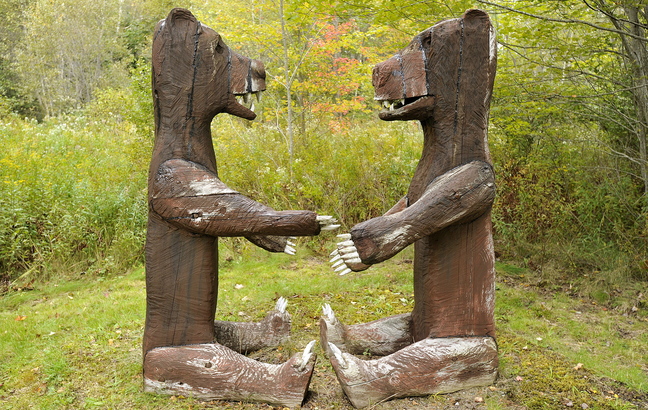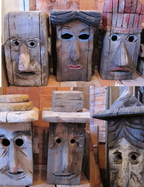The city of Portland is looking for a decent home for a few homeless bears.
As part of an initiative to restore public confidence in its work, the Portland Public Art Committee is encouraging input from residents to help place two larger-than-life sculptures made by the late Maine sculptor Bernard “Blackie” Langlais. The city will receive several Langlais sculptures this fall, including one standing bear that’s 10 feet tall and a pair of seated bears facing one another. The seated bears are almost 7 feet tall.
The committee has picked locations for most of the other pieces it is in line to receive, but faces a quandary about the bears. They are big and robust, and the committee can only place them inside city-owned buildings.
“They are homeless bears that any one of us would love to have,” said Lin Lisberger, who chairs the Public Art Committee.
The committee has been bombarded with criticism for a series of unpopular decisions regarding its commissioning of public art. It hopes this project turns the tide of public opinion.
Langlais was a popular artist with deep Maine roots who was embraced by the high-art world as well as everyday folks. He was born in Old Town, studied at the Skowhegan School of Painting and Sculpture and made his name in New York before returning to his native state and settling in Cushing on Maine’s midcoast.
His work is considered both cultured and accessible, said Jack Soley, who was chairman of the committee when the Langlais project began. He is no longer on the art committee, but remains involved in the project. He’s also on the planning board.
Langlais, who died in 1977, was known for constructing whimsical, playful sculptures from discarded pieces of wood. His best-known piece may be a 62-foot tall Abenaki Indian that towers over Skowhegan, though he was most prolific creating lions, tigers, bears and other animals.
After the death of his widow, Helen, in 2010, the Langlais estate at Cushing went to Colby College, which then gifted most of it to the Wisconsin-based Kohler Foundation. Kohler is giving away most of the rest of it, including the pieces that are coming to Portland.
In all, Portland is receiving eight sculptural pieces free of charge.
Many of the sculptures have been sitting out in the elements for years. The foundation will fully conserve the sculptures before they come to Portland and pay the cost of transporting them. The art committee will spend about $30,000 preparing sites for the sculpture, Lisberger said. That money will come from its existing budget, she added.
The Portland Public Library is getting an elephant that’s almost 7-feet tall, as well a pair of acrobatic dogs. The Peaks Island library branch will receive a two-sided lion’s head that Langlais carved.
The city also is receiving a total of eight bird houses carved like human heads, each about 3-feet tall. It is dividing those eight into two groups of three and a group of two. Portland and Deering high schools each will receive one group, and the third will go to another school still to be determined.
That leaves the bears homeless.
The Public Art Committee has talked internally about placing one bear sculpture in the soon-to-be-renovated terminal of the Casco Bay Lines and the other at Ocean Gateway, the cruise ship terminal that is just east of Casco Bay Lines terminal. Both buildings are owned by the city, and both receive a lot of traffic, Lisberger said. Temporarily, they may reside at City Hall until a permanent home is found.
“They are both what we call ‘gateway pieces,’ and we want them in a location where a lot of people will see them,” she said.
Before committee members make a decision and a proposal to the City Council, they want input from the public. The Public Art Committee is an advisory board, and ultimately its recommendations must be ratified by the City Council.
Lisberger said she hopes to present the council with a formal proposal to accept and place all the sculpture this fall.
The location choices are limited. The sculptures must be placed indoors, and the committee only can place them in city-owned buildings. That means schools, libraries, municipal buildings and the like are candidates.
The committee considered offering some pieces to the Portland International Jetport, but airport director Paul Bradbury has already placed several monumental pieces by the other artists on the grounds, and has plans to locate smaller sculptures inside the terminal. The committee worried that the Langlais pieces might get lost among the other airport art.
Other possibilities include Hadlock Field home of the Portland Sea Dogs baseball team, or possibly the Cumberland County Civic Center, which is county owned. Hadlock might work, but the sculpture would have been protected from the weather. If the civic center emerges, the art committee would have to allow for placing art in a building not owned by the city, which might require a change in its bylaws.
At least when it comes to public opinion, the art committee has a spotty record. It commissioned an artist to create a grass-based sculpture at Boothby Square in the Old Port, but the grass never came in as hoped and the committee decommissioned the work, scrapping the project after relentless complains by neighbors. A plan to place high-design benches along the Bayside Trail was also ditched when the price skyrocketed beyond the budget.
At Hadlock Field, the committee wanted no part of “American Baseball Family,” a bronze sculpture commissioned by Sea Dogs owner Dan Burke and unveiled in 2007. But the City Council ignored the art committee advice, and accepted the sculpture anyway.
Soley said the Langlais project isn’t about righting wrongs as much as it is about doing the right thing.
“This is not about redeeming past mistakes, but about moving forward and creating opportunity for the city we haven’t seen in many, many years,” he said.
Susan Kelly, preservation coordinator for the Kohler Foundation, said the foundation has given away nearly the entire remaining Langlais collection to 45 institutions across Maine. The collection includes many wood sculptures similar to what Portland is receiving, as well as paintings, drawings and wood reliefs.
“The interest has been tremendous,” Kelly said. “Once word got out, we didn’t have to search out recipients. They came and found us.”
Steve Podgajny, the library director, welcomed the Langlais sculptures into the library collection.
The library already has a large collection of art, and hosts rotating exhibitions in its Lewis Gallery. Art is a core part of the ambiance and cultural experience of the library, Podgajny said, adding that the library receives about a half-million visits annually.
The Langlais pieces will enhance the library experience, he said.
One sculpture will be placed at the landing at the top of the stairs leading to the second floor. The location of the other piece is to be determined.
“I feel like they are incredibly accessible,” Podgajny said. “They are playful. They have a lot of joy embedded in them, and they work with the amount of time and the kind of exposure that someone might have in terms of time and passing through in a busy public space. … For us, it’s not a situation where we said, ‘Oh, we’ll store them for you.’ They’re an integral part of the library experience and we’re thrilled to be getting them.”
Soley visited the Langlais estate several times, and brought along his colleagues from the Public Art Committee. “We were like kids in a candy store,” Soley said. “I was just hoping we would receive at least a single monumental piece and bring renewed interest to Langlais’ work and put him back on the map in Portland.”
That the committee was able to receive at least three monumental pieces – the bears and the elephant – as well as several smaller pieces was more than Soley imagined possible.
“I think the greatest thing about Langlais’ work is its brilliance and its accessibility to the non-artists, and yet it was put together with tremendous skills. He is very well-regarded in the high-art world,” he said.
Before turning the estate over to Kohler, the Colby museum culled a few hundred pieces, and will mount a major Langlais retrospective next year. The Portland Museum of Art hosted a Langlais exhibition in 2002.
Nearly every major museum in Maine is receiving some work, Kelly said.
Commercially, Langlais’ work sells for a few thousand dollars to tens of thousands of dollars. Based on the pricing of his pieces available for purchase today, the value of the work coming to Portland might be as high as $250,000.
Based on what she has learned about the artist, Kelly said she believes he would be very happy that so much of his work is ending up with public institutions, available for anybody to appreciate.
“From stories that people have told us, he was very welcoming. He never turned anyone away who wanted to visit the property or stay on the property. I think this would have made him very happy,” she said.
Soley was one of those people. When he was a middle school student, Soley took a school trip to Cushing. He recalls meeting Langlais, and remembers the artist encouraging Soley and his buddies “to scamper all around these fantastic pieces.”
Bob Keyes can be contacted at 791-6457 or:
bkeyes@pressherald.com
Twitter: pphbkeyes
Send questions/comments to the editors.





Success. Please wait for the page to reload. If the page does not reload within 5 seconds, please refresh the page.
Enter your email and password to access comments.
Hi, to comment on stories you must . This profile is in addition to your subscription and website login.
Already have a commenting profile? .
Invalid username/password.
Please check your email to confirm and complete your registration.
Only subscribers are eligible to post comments. Please subscribe or login first for digital access. Here’s why.
Use the form below to reset your password. When you've submitted your account email, we will send an email with a reset code.